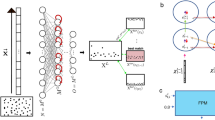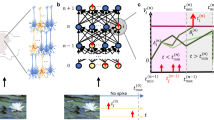Abstract
Experimental results suggest that the time structure of neuronal spike trains can be relevant in neuronal signal processing. In view of these results, a shift of interest from analog neural networks to spike-processing neural networks has been observed. For tasks like image processing the simulation of these networks has to be performed with the speed of biological neural networks. We investigated the performance of available hardware and showed, that the required performance for large networks could not be achieved. According to these results we formulated concepts for the design of dedicated hardware for spike-processing neurons. For an efficient hardware implementation it is necessary to know the requisite precision for computations. Through simulations with fixed-point numbers we examined the effects of word length limitation on the behaviour of a spike-processing network. The network was able to perform its basic task as long as the word length does not fall below a certain limit. On this basis we derived conditions for the lower bound of the requisite word length.
Preview
Unable to display preview. Download preview PDF.
Similar content being viewed by others
References
Eckhorn R, Bauer R, Jordan W, Brosch M, Kruse W, Munk M. Reitboeck HJ (1988) Coherent oscillations: A mechanism of feature linking in the visual cortex ? Biol Cybern 60:121–130
Eckhorn R, Reitboeck HJ, Arndt M, Dicke P (1989) Feature linking via stimulus-evoked oscillations: Experimental results from cat visual cortex and functional implication from a network model. Proc ICNN I:723–730
Gerstner W, Ritz R, Hemmen JL van (1993) A biologically motivated and analytically soluble model of collective oscillations in the cortex. Biol Cybern 68:363–374
Gray CM, Singer W (1989) Stimulus-specific neuronal oscillations in orientation columns of cat visual cortex. Proc Natl Acad Sci USA 86:1698–1702
Hammerstrom D (1990) A VLSI Architecture for High-Performance, Low-Cost, On-Chip Learning. Proc. IJCNN II: 537–543.
Hartmann G (1992) Hierarchical neural representations by synchronized activity: a concept for visual pattern recognition. In: Neural Network Dynamics, edited by J. G. Taylor et al. (Springer, Berlin et al.) pp 356–370
Hartmann G (1993) 1. Workshop zum Förderungsschwerpunkt „Elektronisches Auge“. Summary: 10–19.
Horn D, Usher M (1991) Segmentation and Binding in an oscillatory neural network. Proc IJCNN II:243–248
Koenig P, Schillen W (1991) Stimulus-dependent assembly formation of oscillatory responses: I. Synchronization. Neural Comput 3(2):155–166
Maas W (1994) On the computational complexity of networks of spiking neurons. NeuroCOLT Technical Report NC-TR-94-021
Malsburg C von der, Schneider W (1986) A neural cocktail-party processor. Biol Cybern 54:29–40
Prange SJ, Klar H (1993) Cascadable Digital Emulator IC for 16 Biological Neurons. Proc ISSCC: 243–244.
Ramacher U, Beichter J, Brüls N (1991) Architecture of a General Purpose Neural Signal Processor. Proc IJCNN I: 443–446.
Reitboeck HJ, Stoecker M, Hahn C (1993) Object separation in dynamic neural networks. Proc IEEE Int Conf Neural Networks II:638–641
Sompolinsky H, Golomb D, Kleinfeld D (1990) Global processing of visual stimuli in a neural network of coupled oscillators. Proc Natl Acad Sci USA 87:7200–7204
Sporns O, Gally JA, Reeke GN, Edelman GM (1989) Reentrant signalling among neuronal groups leads to coherency in their oscillatory activity. Proc Natl Acad Sci USA 86:7265–7269
Author information
Authors and Affiliations
Editor information
Rights and permissions
Copyright information
© 1995 Springer-Verlag Berlin Heidelberg
About this paper
Cite this paper
Roth, U., Jahnke, A., Klar, H. (1995). Hardware requirements for spike-processing neural networks. In: Mira, J., Sandoval, F. (eds) From Natural to Artificial Neural Computation. IWANN 1995. Lecture Notes in Computer Science, vol 930. Springer, Berlin, Heidelberg. https://doi.org/10.1007/3-540-59497-3_243
Download citation
DOI: https://doi.org/10.1007/3-540-59497-3_243
Published:
Publisher Name: Springer, Berlin, Heidelberg
Print ISBN: 978-3-540-59497-0
Online ISBN: 978-3-540-49288-7
eBook Packages: Springer Book Archive




